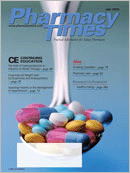Publication
Article
Pharmacy Times
Elder Prescription Drug Abuse
Author(s):
As my baby boom generationbegins to receive AARP mailingsmore and more each yearand is approaching free coffee atMcDonald's, the question of prescriptiondrug abuse rears its ugly head inthe government's latest check on emergencyroom visits.
Inspectors found that, in 2004,almost 64,000 people 55 years of ageand older visited the emergencyroom of local hospitals for prescriptiondrug abuse.
This probably should not surprisemost of us, since this generation grewup in the 1960s and 1970s at the startof the illegal drug trade in this country.Marijuana, LSD, heroin, and even prescriptiondrugs were widely abused oncollege campuses during the babyboom era.
I was a young uniform police officerin the very early 1970s when oxycodone,hydromorphone, codeine,diazepam, pentazocine, methaqualone,and assorted amphetamines werebeing sold and abused regularly. It wasmy first exposure to pharmaceuticalabuse, and I quickly learned that itcould be every bit as devastating asheroin usage.
For years physicians have prescribedregular monthly dosages of propoxypheneto elderly patients for theiraches and pains and diazepam fortheir anxiety or inability to fall asleep.Some experts have suggested thatthese drugs had no real purpose forthe elderly and kept them dependenton steady doses of pain relievers andbenzodiazepines for no sound medicalreason.
A common practice years ago, andstill today in urban settings, is for seniorsto sell their medications every month. Thedrugs are prescribed for pain or anxiety,and are either free or boughtwith a small copay. One ormore enterprising individualsin the neighborhood wouldapproach these fixed-incomefolks withoffers of $1 to $2per pill. This representeda steady income forthe seniors and at least doublethe profit for drug-dealing entrepreneurswho turn them over quickly.
These dealers were sometimes thepeople that appeared on the surfaceto be Good Samaritans taking theolder generation to the doctor andthen to the neighborhood pharmacy.The problem is that when they separated,the wrong person had the pills,and the senior had a few extra bucksin his or her pocket.
Once tipped off by the physician'soffice or pharmacy, we watched manyof these transactions take place fromcovert locations, and made arrestsaccordingly. It is a hard lesson to learnfor money-strapped senior citizenswho then find themselves involved infelony drug-trafficking offenses.
How do you spot drug dealers orabusers by just looking at them at yourpharmacy counter? The problem is thatyou cannot, and some of the oldstereotypes that were not alwaysaccurate years ago are getting moredifficult as the babyboomers consumemore and more prescriptiondrugs, with a growingpercentage needing helpwith their dependence on oraddiction to pharmaceuticals.
I am not suggesting that you aggressivelyinterrogate the next 70-year-oldpatient that comes to your counter, butsenior abuse of prescription drugs isgrowing, and it is important that pharmacypersonnel recognize it when ithappens. If a crime is being committed,recognizing and doing somethingabout it may very well save thatsenior's life.
John Burke, commander ofthe Warren County, Ohio,drug task force and retiredcommander of the CincinnatiPolice PharmaceuticalDiversion Squad, isa 38-year veteran of lawenforcement. Cmdr Burkealso is the current presidentof the National Association of Drug DiversionInvestigators. For information, he can bereached by e-mail at [email protected], viathe Web site www.rxdiversion.com, or byphone at 513-336-0070.

Newsletter
Stay informed on drug updates, treatment guidelines, and pharmacy practice trends—subscribe to Pharmacy Times for weekly clinical insights.






